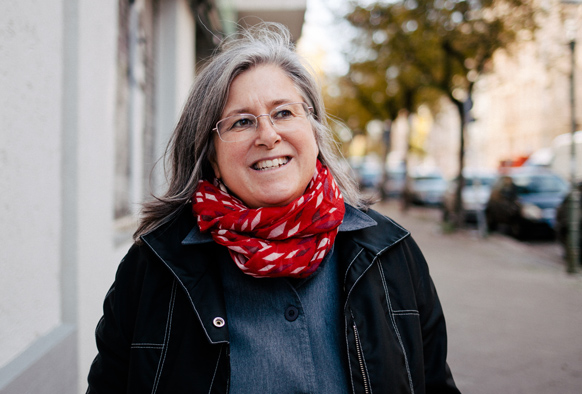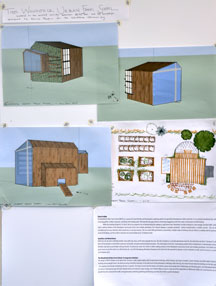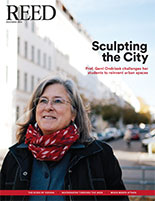
IRIS login | Reed College home Volume 94, No. 4: December 2015
Sculpting the City

Prof. Gerri Ondrizek challenges her students to reinvent urban spaces
By Randall S. Barton
On the rise above Reed lies Woodstock, a neighborhood of 11,000 that has long been the stomping ground for students, professors, and staff. Like many Portland neighborhoods, Woodstock—which once looked like a small-town Main Street—is undergoing rapid change. A gleaming New Seasons Market offers upscale groceries and wild salmon. A Grand Central Bakery is crowded with millennials nursing lattés. The old RadioShack is now the Portland Fish Market, Country Bill’s Restaurant has become Gentle Dental, and Dick’s Kitchen is opening across from the Woodstock Library. Having witnessed the sudden transformation of other neighborhoods nearby, residents have both pride and trepidation about Woodstock’s future.
In 2014, Reed worked with neighbors, developers, and city planners to host a charrette—a conference where stakeholders can explore what the neighborhood might look like in 25 years. The charrette issued a report on the current state of Woodstock that contained some eye-catching statistics.
Nearly 8% of the roadways crisscrossing Woodstock lack some combination of pavement, curbs, or sidewalks, compared with 1.9% citywide. Because fire trucks have other access and there are no plumbing or electrical lines running through them, these roadways are likely to remain unpaved—which gave Prof. Gerri Ondrizek [art 1994-] an idea.
Every few years she teaches a 300-level art class called Intersection: Sculpture, Landscape, Architecture that investigates the junction between architecture and sculpture and challenges students to meet the psychological and physical needs of people using spaces. In 2011 the students studied the difference between commercial architecture and the kind of work done by Architects for Humanity. This year the study was weighted more towards outdoor sculptural installations

Ondrizek’s students learned how to do simple scale drafting, write architectural briefs, make presentation boards, build scale models, and defend their projects in an oral presentation.
The nine students in the class were asked to look at a drab, featureless, unimproved crossroad measuring 225 square feet, and reimagine it as an asset to the community.
They read A Pattern Language by Christopher Alexander, which explains how architecture and urban plans are made through patterns. Bachelard’s The Poetics of Space got them thinking about space and phenomenology, and Martin Heidegger’s Building, Dwelling, Thinking purported (among other things) that building is really about dwelling in a place—particularly in peace.
To open their minds, they studied experimental projects sponsored by New York’s Museum of Modern Art and read Hal Foster’s Design and Crime, about how the world is being “Frank Gehryed” with spectacular, cool-looking architecture. “Is it working?” Foster asks. “Do we need something so elaborate that costs so much money?’”
Prof. Ondrizek encouraged her students to push the edges and offer something different.
“I’m not interested in students making something that looks pretty, a precious object to be bought and sold,” she says. “I’d like them to leave here trained to think about architecture, art, and politics.”
![]()
Widely exhibited in galleries and museums, Ondrizek has been featured in 34 solo exhibitions and numerous group shows. For the last 20 years she has created architectural-scaled works that house medical and biological information, working with geneticists and biologists to gather and compose images of human cellular tissue and genetic tests that relate to ethnic identity and disease. She earned an MFA from the University of Washington, and when she was working on her BFA at Carnegie-Mellon University, interned at an installation museum in Pittsburgh called the Mattress Factory.
“It was the 1980s and we had thrown out the object, right?” she recalls. “We were dealing with material semiotics, dealing with space. We were taught that would be the future, and while it hasn’t come to pass in quite that way, I’m decidedly not a gallery artist.”
Urging students to use space to offer something new, she encourages them to pay attention to how the structures they are creating would be impacted by the sun, the wind, and the rain, as well as the trees and the building next door.
“I want the students to consider how we feel and act in and around spaces made from different materials and at different scales,” she says.
You feel different standing next to a five-story concrete structure than you do in a windowed, wooden house. The latter is informed by nature, and its scale and pattern is more familiar than the impenetrable concrete form. Humanistic spaces serve the psychological and physical needs of those using them.
“Not to say that one material is bad and another good,” Ondrizek adds, “but attention to the form and pattern being set up in a space is essential.”
While students may discover the emblematic Swiss architect Le Corbusier in Urban Anthropology, or discuss the Haussmannization of Paris during the history of modernity in Hum 220, Reed offers no formal classes in architecture. So the Intersection class is a rare opportunity. As one of the students, Rennie Meyers ’15, observed: "It's absolutely a unique class at Reed."
Prof. Ondrizek is adamant that art classes present opportunities to interact physically with the material world.
“What we’re putting together is not just a sentence they can pack, unpack, and reform,” she says. “We live in a material world and you need to know about materials and how to make decisions on levels that have multiple repercussions.”
Before taking the class, students need to have completed Sculpture I or have a basic knowledge of sculpture materials, woodshop, and/or welding skills. Sculpture I teaches how to build with wood, think about skeletal structure and physics, and the formal language of making something.
So while the Intersection class is about the convergence of sculpture and architecture, it proposes taking a potholed roadway—bereft of either car or foot traffic—and re-imagining it as a neighborhood asset.
Students learn to do simple scale drafting, write architectural briefs, make presentation boards, build a scale model, and defend their projects in an oral presentation.
For her individual project, Rennie designed an urban farm school, replete with a chicken coop, small gardens, and an outdoor learning center with reading nook and lending library to encourage learning and the exchange of ideas about urban farm development.
“I liked the cutting-edge technologies we were exposed to, like the laser used to cut our models,” she said. “Gerri’s interested in theory, so we were asked to negotiate the theoretical and the practical, and that’s not always a negotiation where you’re sacrificing one or the other.”
Students in the class designed meditational spaces, gardens with tables and lounge beds, and covered porches that face one another and can be slid together to form a single structure.
Lucy Weisner ’16 wanted to create something that was participatory but did not impose architectural structures. She fabricated a folding chair that can be stored in a box and moved from site to site as portable placemaking.
Inspired by philosopher Martin Heidegger’s musings about voids—for example that a jug’s “thingness” is informed by its void—Chloe Truong-Jones ’16 created a subterranean chamber. The project reflected her interest in the notion that “to build upwards you have to start downwards.”
For their final project the students broke into three groups, each taking a block along Woodstock Boulevard and reimagining it as a civic space. During the charrette, Woodstock residents complained that the neighborhood is boring. Ondrizek asked teams to create a “third space,” one that was neither home nor work, where people could recreate. Students were to consider LEED standards and use only low-impact materials. Drawings of the scanned models were superimposed on photographs and maps of the actual locations.
“I get them to work in teams because in the real world none of us are really solo geniuses, out there flying alone and predicting how things will happen,” Ondrizek says. “We have to collaborate, coordinate, form partnerships and relationships, and appreciate other people’s fields.”
One team transformed what is now a BiMart store and strip mall into a residential, entertainment complex fronted by a Japanese-style garden. Explaining his vision for the garden, Wyatt Heidenfelder ’15 said he wanted “something that is more felt than seen, a contemplative space where you can’t chart your adventure.”
Another team proposed to raze the Key Bank and punctuate the streetscape with an art gallery and lecture space surrounded by landscaping. The team envisioned the facility funded and shared by area colleges and universities. Three pods at the rear of the property would serve as residences and studios for visiting lecturers and artists.
The third team took a piece of unimproved roadway on Southeast Knight Street and imagined it as a community space and mutable market, including a farmers’ market. The space would be lined with 10’ tall LED poles to which canvas tents could be affixed for vendors, and the design incorporated transit pathways, a small stage for musical performances, and picnic tables.
“The beauty of this particular project is that no decision can be made without affecting 20 other things around it,” Ondrizek notes. “In the world you’re part of a bigger picture.”
While a commercial developer would probably focus on condos or strip malls, she pushed her students to think sculpturally and artistically.
“I realize these projects might look like completely absurd gestures for the Woodstock neighborhood,” she says, “but it’s important to push the population to think what art can be. It doesn’t necessarily have to be an object, a bronze statue of a deer or a beaver, which Portland loves. It can be a picnicking area where everything from the plants to the sunlight to the furnishings is considered part of the sculptural paradigm.”
The art world of museums and galleries tends to be contemplative, gazing at its navel without regard for the world at large. As they digest the principles that govern the intersection of architecture and sculpture, Ondrizek’s students are forced to think in terms of social practices and how to interface with the rest of the world.

LATEST COMMENTS
steve-jobs-1976 I knew Steve Jobs when he was on the second floor of Quincy. (Fall...
Utnapishtim - 2 weeks ago
Prof. Mason Drukman [political science 1964–70] This is gold, pure gold. God bless, Prof. Drukman.
puredog - 1 month ago
virginia-davis-1965 Such a good friend & compatriot in the day of Satyricon...
czarchasm - 4 months ago
John Peara Baba 1990 John died of a broken heart from losing his mom and then his...
kodachrome - 7 months ago
Carol Sawyer 1962 Who wrote this obit? I'm writing something about Carol Sawyer...
MsLaurie Pepper - 8 months ago
William W. Wissman MAT 1969 ...and THREE sisters. Sabra, the oldest, Mary, the middle, and...
riclf - 10 months ago